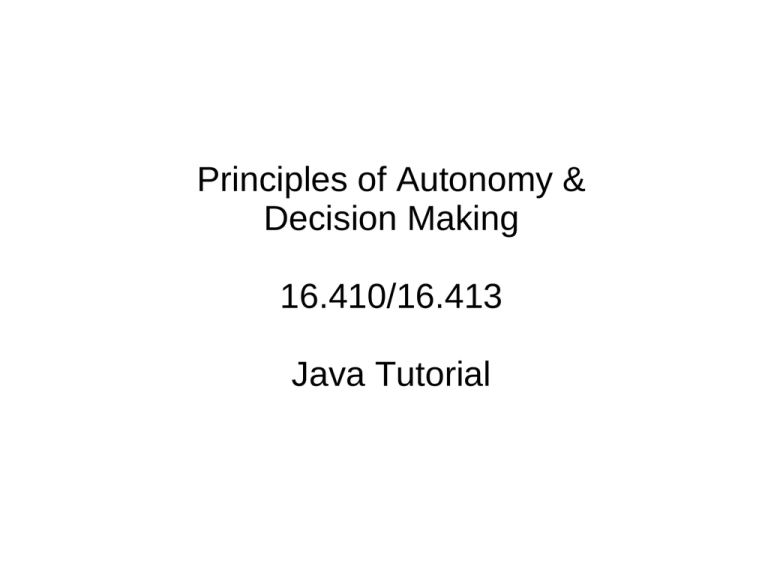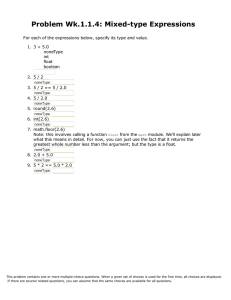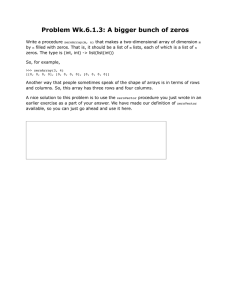Document 13479869
advertisement

Principles of Autonomy &
Decision Making
16.410/16.413
Java Tutorial
Useful Reference
• If you need to learn Java syntax:
– Sun Java Tutorial
– http://java.sun.com/docs/books/tutorial/
• If you want to know about available packages:
– http://java.sun.com/javase/6/docs/api/
• You can find a link to these pages from the
course website under “Materials”
Graph
• Directed Graph
⎯ A directed graph or digraph G is an ordered pair G:= (V,
E) with
• V is a set, whose elements are called vertices or nodes,
• E is a set of ordered pairs of vertices, called directed
edges, arcs, or arrows.
Image by MIT OpenCourseWare.
• Undirected Graph
⎯ An undirected graph G is an ordered pair G:= (V, E) that
is subject to the following conditions:
• V is a set, whose elements are called vertices or nodes,
• E is a set of pairs (unordered) of distinct vertices,
called edges or lines.
Image by MIT OpenCourseWare.
Graph as Adjacency Matrix
Directed Graph
0
2
1
0
1
2
0
false
true
false
1
false
false
true
2
true
false
false
0
1
2
0
false
true
true
1
true
false
true
2
true
true
false
Image by MIT OpenCourseWare.
Undirected Graph
0
1
2
Image by MIT OpenCourseWare.
Let’s Begin Coding
• Graph Class (i.e. Directed Graph)
⎯ Member Variables: Data stored in the object
• protected boolean m_edges [][];
⎯ Constructors: How the object should be initialized
• public Graph()
• public Graph(int vertexCount);
⎯ Methods: Available operations on the object
• public void addEdge(int from, int to)
• public void deleteEdge(int from, int to)
—
• public boolean isConnected(int from, int to)
• public Set<Integer>getAdjacentVertices(int from)
Difference between
Directed and Undirected
• UndirectedGraph Class
⎯ Member Variables: Data stored in the object
• protected boolean m_edges[][];
⎯ Constructors: How the object should be initialized
• public Graph()
• public Graph(int vertexCount)
⎯ Methods: Available operations on the object
• public void addEdge(int from, int to)
• public void deleteEdge(int from, int —
to)
• public boolean isConnected(int from, int to)
• public Set<Integer> getAdjacentVertices(int from)
Difference between
Directed and Undirected
• UndirectedGraph Class
⎯ Member Variables: Data stored in the object
• protected boolean m_edges[][];
⎯ Constructors: How the object should be initialized
• public Graph()
• public Graph(int vertexCount)
⎯ Methods: Available operations on the object
• public void addEdge(int from, int to)
• public void deleteEdge(int from, int to)
• public boolean isConnected(int from, int to)
• public Set<Integer> getAdjacentVertices(int from)
Inheritance
• Let UndirectedGraph inherit Graph
⎯ Only implement the methods that are different.
⎯ The undefined methods will be inherited from the Graph
class.
public class UndirectedGraph extends Graph {
public Graph(int vertexCount) {
}
public void addEdge(int from, int to) {
}
public void deleteEdge(int from, int to) {
}
}
Test Cases
Directed Graph
Undirected Graph
0
0
1
3
2
4
5
1
6
Image by MIT OpenCourseWare.
What is adjacent to 2?
⎯ (5, 6)
3
2
4
5
6
Image by MIT OpenCourseWare.
What is adjacent to 2?
⎯ (0, 5, 6)
What You Should Know
• Basics of Programming
• Basic Object Oriented Programming:
⎯ Inheritance
⎯ Abstract Class
• Some methods may be specified, but not
implemented.
⎯ Interface
• Methods are specified, but not implemented.
What You Should Know
• Collections (i.e. Containers)
⎯ Set <T>
• Unordered collection of elements, without duplicates.
⎯ List <T>
• Ordered collection of elements.
⎯ Queue <T>
• Allow adding elements to the back and removing from
the front.
⎯ Stack <T>
• Allow pushing elements to the top and popping from
the top.
• Templates
⎯ Allows the user to specify the object type of the
elements, e.g. Set<Integer> is a set of integers.
MIT OpenCourseWare
http://ocw.mit.edu
16.410 / 16.413 Principles of Autonomy and Decision Making
Fall 2010
For information about citing these materials or our Terms of Use, visit: http://ocw.mit.edu/terms.




